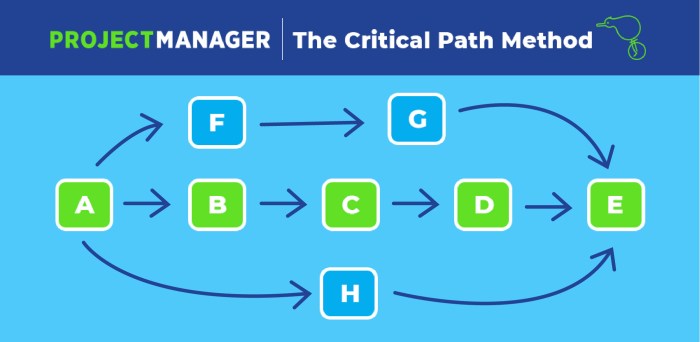Which of the following statements regarding critical paths is true – Delving into the realm of project management, we embark on a quest to unravel the intricacies of critical paths, their profound impact on project outcomes, and the strategies employed to effectively navigate their complexities. This discourse promises to shed light on the true nature of critical paths, empowering project managers with the knowledge and tools to harness their potential for project success.
Critical paths, the lifelines of projects, dictate the minimum time required for completion. Understanding their characteristics, identifying them with precision, and managing them strategically are paramount to ensuring timely project delivery. This exploration will delve into the methodologies and techniques that illuminate critical paths, enabling project managers to mitigate risks, minimize delays, and ultimately achieve project objectives with efficiency and precision.
1. Definition and Importance of Critical Paths
In project management, a critical path refers to the sequence of tasks that directly impacts the overall project duration. Identifying critical paths is crucial for project success, as any delays in these tasks can result in delays in the entire project.
2. Characteristics of Critical Paths
Critical paths are characterized by their zero float, meaning that they have no slack time or buffer. This implies that any delay in a task on the critical path will directly affect the project deadline. The duration and dependencies of tasks along the critical path play a significant role in determining the overall project duration.
3. Identifying Critical Paths: Which Of The Following Statements Regarding Critical Paths Is True

Various methods can be used to identify critical paths in projects. One common approach is the critical path method (CPM), which involves creating a network diagram that represents the tasks and their dependencies. By analyzing the network diagram, project managers can determine the critical path.
4. Managing Critical Paths

Effectively managing critical paths is crucial to ensure timely project completion. Strategies for managing critical paths include identifying and mitigating risks, allocating additional resources, and optimizing task durations. By closely monitoring and controlling tasks along the critical path, project managers can minimize delays and maintain the project timeline.
5. Examples of Critical Paths

Real-world examples of projects with well-defined critical paths include software development projects, construction projects, and product launch campaigns. In these projects, identifying and managing critical paths is essential to meet deadlines, control costs, and deliver successful outcomes.
FAQ Section
What is the significance of identifying critical paths?
Identifying critical paths is crucial as they dictate the minimum time required for project completion. By understanding the critical path, project managers can prioritize tasks, allocate resources effectively, and mitigate risks to ensure timely project delivery.
How do task durations and dependencies impact critical paths?
Task durations and dependencies play a significant role in determining the critical path. Longer task durations or increased dependencies can extend the critical path, potentially delaying project completion. Project managers must carefully consider these factors when planning and executing projects.
What are some strategies for managing critical paths effectively?
Effective critical path management involves techniques such as task sequencing, resource allocation, and risk mitigation. Project managers can prioritize tasks along the critical path, assign skilled resources, and identify potential risks to proactively address them, ensuring the project stays on track.